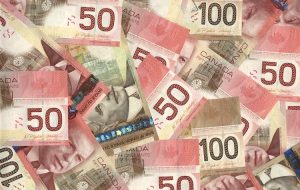Canadian Dollar rises against US Dollar, BoC rate call looms ahead
Share: Canadian Dollar catching some lift as the broad-market US Dollar Index recedes. The Bank of Canada lands with its next rate call on Wednesday. Market sentiment is improving on Monday, sending the Greenback lower. The Canadian Dollar (CAD) is finding some lift to kick off the new trading week, bolstered by investors

- Canadian Dollar catching some lift as the broad-market US Dollar Index recedes.
- The Bank of Canada lands with its next rate call on Wednesday.
- Market sentiment is improving on Monday, sending the Greenback lower.
The Canadian Dollar (CAD) is finding some lift to kick off the new trading week, bolstered by investors finding their risk appetite in early trading. With the US Purchasing Manager Index (PMI), US Gross Domestic Product (GDP), and US Personal Consumption Expenditure (PCE) Index data all due in the upcoming week, the US Dollar (USD) is going to see plenty of play in the markets in the coming days.
The Bank of Canada (BoC) brings forth its latest rate call on Wednesday with a press conference to follow. The BoC holding their reference rate at 5% is a foregone conclusion, but investors will be watching for any hints of when the Canadian central bank will begin looking at rate cuts.
Daily Digest Market Movers: Canadian Dollar buoyed by US Dollar selling pressure
- The CAD is getting bolstered by broad-market pressure forcing down the USD.
- Crude Oil is also seeing declines for Monday, limiting upside potential in the oil-backed Loonie.
- US PMI figures will be released on Tuesday, overshadowing low-impact Canadian housing prices.
- Canadian New Housing Price Index is expected to show 0.1% gains in September.
- US PMI components are expected to decline slightly; Manufacturing is forecast at 49.5 (last 49.8), and Services is seen at 49.9 (last 50.1).
- The BoC’s next rate call is broadly anticipated to hold at 5%, and investors are hoping for signs that the Canadian central bank will start looking ahead to rate cuts sooner rather than later.
- Potential supply constraints stemming from the Gaza Strip conflict are easing as diplomatic efforts are underway to cool Middle East tensions, pulling back oil bids.
Technical Analysis: Canadian Dollar finds room to stretch in Monday’s mild US Dollar sell-off
The Canadian Dollar (CAD) is getting a bump up the charts as the US Dollar wanes across the broader market space, taking the USD/CAD lower on Monday and testing below 1.3700, .
After Friday’s bump into its highest bids in almost two weeks, the USD/CAD is fumbling the 1.3700 handle, setting an intraday low of 1.3667 after slipping from the day’s peak at 1.3736.
Monday’s chart action has the USD/CAD set to print an inside candle to kick off the week, and traders will be keeping an eye on any breakouts from immediate chart territory. Near-term technical support sits at the 50-day Simple Moving Average (SMA), which is currently rising into 1.3600, while the ceiling sits at the last swing high into 1.3785.
Bank of Canada FAQs
The Bank of Canada (BoC), based in Ottawa, is the institution that sets interest rates and manages monetary policy for Canada. It does so at eight scheduled meetings a year and ad hoc emergency meetings that are held as required. The BoC primary mandate is to maintain price stability, which means keeping inflation at between 1-3%. Its main tool for achieving this is by raising or lowering interest rates. Relatively high interest rates will usually result in a stronger Canadian Dollar (CAD) and vice versa. Other tools used include quantitative easing and tightening.
In extreme situations, the Bank of Canada can enact a policy tool called Quantitative Easing. QE is the process by which the BoC prints Canadian Dollars for the purpose of buying assets – usually government or corporate bonds – from financial institutions. QE usually results in a weaker CAD. QE is a last resort when simply lowering interest rates is unlikely to achieve the objective of price stability. The Bank of Canada used the measure during the Great Financial Crisis of 2009-11 when credit froze after banks lost faith in each other’s ability to repay debts.
Quantitative tightening (QT) is the reverse of QE. It is undertaken after QE when an economic recovery is underway and inflation starts rising. Whilst in QE the Bank of Canada purchases government and corporate bonds from financial institutions to provide them with liquidity, in QT the BoC stops buying more assets, and stops reinvesting the principal maturing on the bonds it already holds. It is usually positive (or bullish) for the Canadian Dollar.
| آموزش مجازی مدیریت عالی حرفه ای کسب و کار Post DBA + مدرک معتبر قابل ترجمه رسمی با مهر دادگستری و وزارت امور خارجه |  آموزش مجازی مدیریت عالی و حرفه ای کسب و کار DBA آموزش مجازی مدیریت عالی و حرفه ای کسب و کار DBA+ مدرک معتبر قابل ترجمه رسمی با مهر دادگستری و وزارت امور خارجه |  آموزش مجازی مدیریت کسب و کار MBA آموزش مجازی مدیریت کسب و کار MBA+ مدرک معتبر قابل ترجمه رسمی با مهر دادگستری و وزارت امور خارجه |
 مدیریت حرفه ای کافی شاپ |  حقوقدان خبره |  سرآشپز حرفه ای |
 آموزش مجازی تعمیرات موبایل آموزش مجازی تعمیرات موبایل |  آموزش مجازی ICDL مهارت های رایانه کار درجه یک و دو |  آموزش مجازی کارشناس معاملات املاک_ مشاور املاک آموزش مجازی کارشناس معاملات املاک_ مشاور املاک |
- نظرات ارسال شده توسط شما، پس از تایید توسط مدیران سایت منتشر خواهد شد.
- نظراتی که حاوی تهمت یا افترا باشد منتشر نخواهد شد.
- نظراتی که به غیر از زبان فارسی یا غیر مرتبط با خبر باشد منتشر نخواهد شد.





ارسال نظر شما
مجموع نظرات : 0 در انتظار بررسی : 0 انتشار یافته : ۰